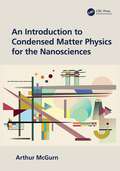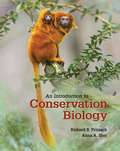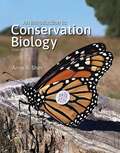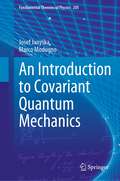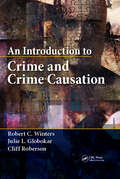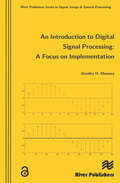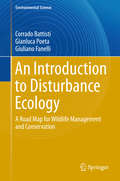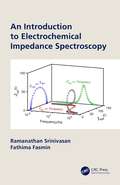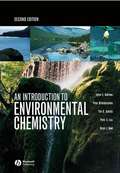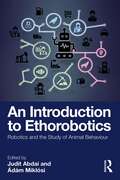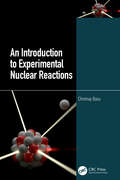- Table View
- List View
An Introduction to Condensed Matter Physics for the Nanosciences
by Arthur McGurnThe book provides an accessible introduction to the principles of condensed matter physics with a focus on the nanosciences and device technologies. The basics of electronic, phononic, photonic, superconducting, optics, quantum optics, and magnetic properties are explored, and nanoscience and device materials are incorporated throughout the chapters. Many examples of the fundamental principles of condensed matter physics are taken directly from nanoscience and device applications. This book requires a background in electrodynamics, quantum mechanics, and statistical mechanics at the undergraduate level. It will be a valuable reference for advanced undergraduates and graduate students of physics, engineering, and applied mathematics. Features Contains discussions of the basic principles of quantum optics and its importance to lasers, quantum information, and quantum computation. Provides references and a further reading list to additional scientific literature so that readers can use the book as a starting point to then follow up with a more advanced treatment of the topics covered. Requires only a basic background in undergraduate electrodynamics, quantum mechanics, and statistical mechanics.
An Introduction to Conservation Biology
by Richard Primack Anna Sher<p>This is a book well suited for a wide range of undergraduate courses, as both a primary text for conservation biology courses and a supplement for ecological and environmental science courses. <p>New coauthor Anna Sher joins longtime Sinauer author Richard Primack in creating a book that combines the readability of Primack's A Primer of Conservation Biology with the depth and coverage of his larger textbook, Essentials of Conservation Biology. The result is a book well suited for a wide range of undergraduate courses, as both a primary text for conservation biology courses and a supplement for ecological and environmental science courses. <p>Using the chapter framework of the current Primer as a springboard, the authors have added three chapters focused on population biology conservation tools (Chapter 7), restoration ecology (Chapter 10), and the future of conservation (Chapter 12). Sustainable development, ex situ conservation, and other key topics have been expanded and updated with hundreds of new examples, explanations, citations, and figures to enhance learning and excitement for the subject. Dr. Sher has mined her experience of having taught conservation biology using Dr. Primack's texts for over a decade to fine-tune the presentation of difficult concepts, particularly in economics and politics. Coverage of recent conservation biology events in the news—such as the poaching of Cecil the Lion, the first papal encyclical on the environment, and the international Paris Accord on climate change—keeps the content fresh and current.</p>
An Introduction to Conservation Biology
by Anna SherAn Introduction to Conservation Biology is the only text designed for both aspiring conservation biologists and non-majors who are interested in this topical field, providing up-to-date perspectives on high-profile issues such as sustainable development, global warming, and strategies to save species on the verge of extinction. The book focuses successively on biological diversity and its value; threats to biological diversity; conservation at the population and species levels; protecting, managing and restoring ecosystems; and sustainable development. Each chapter is beautifully illustrated in full color with diverse examples from the current literature. Chapters begin with guiding conservation biology principles and end with study aids such as summaries, an annotated list of suggested readings, and discussion questions. Throughout, the authors maintain a focus on the active role that scientists, local people, conservation organizations, government, and the general public play in protecting biodiversity, even while providing for human needs.
An Introduction to Continuous-Time Stochastic Processes: Theory, Models, and Applications to Finance, Biology, and Medicine (Modeling and Simulation in Science, Engineering and Technology)
by Vincenzo Capasso David BaksteinThis textbook, now in its third edition, offers a rigorous and self-contained introduction to the theory of continuous-time stochastic processes, stochastic integrals, and stochastic differential equations. Expertly balancing theory and applications, the work features concrete examples of modeling real-world problems from biology, medicine, industrial applications, finance, and insurance using stochastic methods. No previous knowledge of stochastic processes is required. Key topics include:Markov processesStochastic differential equationsArbitrage-free markets and financial derivativesInsurance riskPopulation dynamics, and epidemicsAgent-based modelsNew to the Third Edition:Infinitely divisible distributionsRandom measuresLevy processesFractional Brownian motionErgodic theoryKarhunen-Loeve expansionAdditional applicationsAdditional exercisesSmoluchowski approximation of Langevin systemsAn Introduction to Continuous-Time Stochastic Processes, Third Edition will be of interest to a broad audience of students, pure and applied mathematicians, and researchers and practitioners in mathematical finance, biomathematics, biotechnology, and engineering. Suitable as a textbook for graduate or undergraduate courses, as well as European Masters courses (according to the two-year-long second cycle of the "Bologna Scheme"), the work may also be used for self-study or as a reference. Prerequisites include knowledge of calculus and some analysis; exposure to probability would be helpful but not required since the necessary fundamentals of measure and integration are provided. From reviews of previous editions:"The book is . . . an account of fundamental concepts as they appear in relevant modern applications and literature. . . . The book addresses three main groups: first, mathematicians working in a different field; second, other scientists and professionals from a business or academic background; third, graduate or advanced undergraduate students of a quantitative subject related to stochastic theory and/or applications. " -Zentralblatt MATH
An Introduction to Continuum Mechanics
by J. N. ReddyThis textbook reflects the modern view that scientists and engineers should be trained to think and work in multidisciplinary environments. Topics include derivations of the basic equations of invariant (vector and tensor) and form and specializations of the governing equations to various coordinate systems.
An Introduction to Covariant Quantum Mechanics (Fundamental Theories of Physics #205)
by Josef Janyška Marco ModugnoThis book deals with an original contribution to the hypothetical missing link unifying the two fundamental branches of physics born in the twentieth century, General Relativity and Quantum Mechanics. Namely, the book is devoted to a review of a "covariant approach" to Quantum Mechanics, along with several improvements and new results with respect to the previous related literature. The first part of the book deals with a covariant formulation of Galilean Classical Mechanics, which stands as a suitable background for covariant Quantum Mechanics. The second part deals with an introduction to covariant Quantum Mechanics. Further, in order to show how the presented covariant approach works in the framework of standard Classical Mechanics and standard Quantum Mechanics, the third part provides a detailed analysis of the standard Galilean space-time, along with three dynamical classical and quantum examples. The appendix accounts for several non-standard mathematical methods widely used in the body of the book.
An Introduction to Crime and Crime Causation
by Cliff Roberson Robert C. Winters Julie L. GlobokarAn Introduction to Crime and Crime Causation is a student-friendly textbook that defines and explains the concepts of crime, criminal law, and criminology. Ideal for a one-semester course, the book compares and contrasts early criminal behavior and today‘s modern forms of crime. It also explores society‘s responses to criminal behavior in the past
An Introduction to Data-Driven Control Systems
by Ali Khaki-SedighAn Introduction to Data-Driven Control Systems An introduction to the emerging dominant paradigm in control design Model-based approaches to control systems design have long dominated the control systems design methodologies. However, most models require substantial prior or assumed information regarding the plant’s structure and internal dynamics. The data-driven paradigm in control systems design, which has proliferated rapidly in recent decades, requires only observed input-output data from plants, making it more flexible and broadly applicable. An Introduction to Data-Driven Control Systems provides a foundational overview of data-driven control systems methodologies. It presents key concepts and theories in an accessible way, without the need for the complex mathematics typically associated with technical publications in the field, and raises the important issues involved in applying these approaches. The result is a highly readable introduction to what promises to become the dominant control systems design paradigm. Readers will also find: An overview of philosophical-historical issues accompanying the emergence of data-driven control systems Design analysis of several conventional data-driven control systems design methodologies Algorithms and simulation results, with numerous examples, to facilitate the implementation of methods An Introduction to Data-Driven Control Systems is ideal for students and researchers in control theory or any other research area related to plant design and production.
An Introduction to Design Arguments
by Benjamin C. JantzenThe history of design arguments stretches back to before Aquinas, who claimed that things which lack intelligence nevertheless act for an end to achieve the best result. Although science has advanced to discredit this claim, it remains true that many biological systems display remarkable adaptations of means to ends. Versions of design arguments have persisted over the centuries and have culminated in theories that propose an intelligent designer of the universe. This volume is the only comprehensive survey of 2,000 years of debate, drawing on both historical and modern literature to identify, clarify, and assess critically the many forms of design argument for the existence of God. It provides a neutral, informative account of the topic from antiquity to Darwin, and includes concise primers on probability and cosmology. It will be of great value to upper-level undergraduates and graduates in philosophy of religion, theology, and philosophy of science.
An Introduction to Digital Signal Processing
by Stanley MneneyAn Introduction to Digital Signal Processing aims at undergraduate students who have basic knowledge in C programming, Circuit Theory, Systems and Simulations, and Spectral Analysis. The book is focused on basic concepts of digital signal processing, MATLAB simulation and implementation on selected DSP hardware in which the candidate is introduced to the basic concepts first before embarking to the practical part which comes in the later chapters. Initially Digital Signal Processing evolved as a postgraduate course which slowly filtered into the undergraduate curriculum as a simplified version of the latter. The goal was to study DSP concepts and to provide a foundation for further research where new and more efficient concepts and algorithms can be developed. Though this was very useful it did not arm the student with all the necessary tools that many industries using DSP technology would require to develop applications. This book is an attempt to bridge the gap. It is focused on basic concepts of digital signal processing, MATLAB simulation and implementation on selected DSP hardware. The objective is to win the student to use a variety of development tools to develop applications. Contents• Introduction to Digital Signal processing.• The transform domain analysis: the Discrete-Time Fourier Transform• The transform domain analysis: the Discrete Fourier Transform• The transform domain analysis: the z-transform• Review of Analogue Filter• Digital filter design.• Digital Signal Processing Implementation Issues• Digital Signal Processing Hardware and Software• Examples of DSK Filter Implementation
An Introduction to Distance Measurement in Astronomy
by Richard De GrijsDistance determination is an essential technique in astronomy, and is briefly covered in most textbooks on astrophysics and cosmology. It is rarely covered as a coherent topic in its own right. When it is discussed the approach is frequently very dry, splitting the teaching into, for example, stars, galaxies and cosmologies, and as a consequence, books lack depth and are rarely comprehensive.Adopting a unique and engaging approach to the subject An Introduction to distance Measurement in Astronomy will take the reader on a journey from the solar neighbourhood to the edge of the Universe, discussing the range of distance measurements methods on the way. The book will focus on the physical processes discussing properties that underlie each method, rather than just presenting a collection of techniques.As well as providing the most compressive account of distance measurements to date, the book will use the common theme of distance measurement to impart basic concepts relevant to a wide variety of areas in astronomy/astrophysics.The book will provide an updated account of the progress made in a large number of subfields in astrophysics, leading to improved distance estimates particularly focusing on the underlying physics. Additionally it will illustrate the pitfalls in these areas and discuss the impact of the remaining uncertainties in the complete understanding of the Universes at large. As a result the book will not only provide a comprehensive study of distance measurement, but also include many recent advances in astrophysics.
An Introduction to Distributed Optical Fibre Sensors (Series in Fiber Optic Sensors)
by Arthur H. HartogThis book explains physical principles, unique benefits, broad categories, implementation aspects, and performance criteria of distributed optical fiber sensors (DOFS). For each kind of sensor, the book highlights industrial applications, which range from oil and gas production to power line monitoring, plant and process engineering, environmental monitoring, industrial fire and leakage detection, and so on. The text also includes a discussion of such key areas as backscattering, launched power limitations, and receiver sensitivity, as well as a concise historical account of the field’s development.
An Introduction to Disturbance Ecology: A Road Map for Wildlife Management and Conservation (Environmental Science and Engineering)
by Corrado Battisti Gianluca Poeta Giuliano FanelliThis book represents an introductory review of disturbance ecology and threat analysis, providing schematic concepts and approaches useful for work on sites that are affected by the impact of human actions. It is aimed at conservation and environmental practitioners, who will find tips for choosing methods and approaches when there are conflicts between the natural components and human activity. It is also addressed to students of applied ecology, ecosystem management, land-use planning and environmental impact assessment. It discusses a number of topics covered in the programs of many university courses related to basic ecology and ecology of disturbance, the latter constituting a field of great interest because of its implications and repercussions in applied territorial science. The book is divided into two parts: the first focuses on the theoretical and disciplinary framework of the ecology of disturbance, while the second is devoted to the analysis of anthropogenic threats. This, in particular, discusses the most recent approach, which uses a conventional nomenclature to allow a coarse-grained quantification and objective assessment of threat impact on different environmental components. Such an approach facilitates the comparison of hierarchically different events and, therefore, helps define the priorities for management and conservation strategies.
An Introduction to Dynamic Meteorology
by James R. HoltonThis revised text presents a cogent explanation of the fundamentals of meteorology, and explains storm dynamics for weather-oriented meteorologists. It discusses climate dynamics and the implications posed for global change. Formulas have been removed.
An Introduction to Dynamical Systems and Chaos
by G. C. LayekThe book discusses continuous and discrete systems in systematic and sequential approaches for all aspects of nonlinear dynamics. The unique feature of the book is its mathematical theories on flow bifurcations, oscillatory solutions, symmetry analysis of nonlinear systems and chaos theory. The logically structured content and sequential orientation provide readers with a global overview of the topic. A systematic mathematical approach has been adopted, and a number of examples worked out in detail and exercises have been included. Chapters 1-8 are devoted to continuous systems, beginning with one-dimensional flows. Symmetry is an inherent character of nonlinear systems, and the Lie invariance principle and its algorithm for finding symmetries of a system are discussed in Chap. 8. Chapters 9-13 focus on discrete systems, chaos and fractals. Conjugacy relationship among maps and its properties are described with proofs. Chaos theory and its connection with fractals, Hamiltonian flows and symmetries of nonlinear systems are among the main focuses of this book. Over the past few decades, there has been an unprecedented interest and advances in nonlinear systems, chaos theory and fractals, which is reflected in undergraduate and postgraduate curricula around the world. The book is useful for courses in dynamical systems and chaos, nonlinear dynamics, etc. , for advanced undergraduate and postgraduate students in mathematics, physics and engineering.
An Introduction to Ecological Economics
by Carol Franco Robert Costanza Herman Daly Robert Goodland Richard B Norgaard Ida Kubiszewski John H CumberlandFrom Empty-World Economics to Full-World EconomicsEcological economics explores new ways of thinking about how we manage our lives and our planet to achieve a sustainable, equitable, and prosperous future. Ecological economics extends and integrates the study and management of both "nature's household" and "humankind's household"-An Introduction to
An Introduction to Electrochemical Impedance Spectroscopy
by Ramanathan Srinivasan Fathima FasminThis book covers the fundamental aspects and the application of electrochemical impedance spectroscopy (EIS), with emphasis on a step-by-step procedure for mechanistic analysis of data. It enables the reader to learn the EIS technique, correctly acquire data from a system of interest, and effectively interpret the same. Detailed illustrations of how to validate the impedance spectra, use equivalent circuit analysis, and identify the reaction mechanism from the impedance spectra are given, supported by derivations and examples. MATLAB® programs for generating EIS data under various conditions are provided along with free online video lectures to enable easier learning. Features: Covers experimental details and nuances, data validation method, and two types of analysis – using circuit analogy and mechanistic analysis Details observations such as inductive loops and negative resistances Includes a dedicated chapter on an emerging technique (Nonlinear EIS), including code in the supplementary material illustrating simulations Discusses diffusion, constant phase element, porous electrodes, and films Contains exercise problems, MATLAB codes, PPT slide, and illustrative examples This book is aimed at senior undergraduates and advanced graduates in chemical engineering, analytical chemistry, electrochemistry, and spectroscopy.
An Introduction to Environmental Chemistry
by Tim D. Jickells Peter Brimblecombe Brian Reid Peter S. Liss Julian E. AndrewsThis introductory text explains the fundamentals of the chemistry of the natural environment and the effects of mankind's activities on the earth's chemical systems. Retains an emphasis on describing how natural geochemical processes operate over a variety of scales in time and space, and how the effects of human perturbation can be measured. Topics range from familiar global issues such as atmospheric pollution and its effect on global warming and ozone destruction, to microbiological processes that cause pollution of drinking water deltas. Contains sections and information boxes that explain the basic chemistry underpinning the subject covered. Each chapter contains a list of further reading on the subject area. Updated case studies. No prior chemistry knowledge required. Suitable for introductory level courses.
An Introduction to Environmental Epidemiology
by Gunther F. Craun Evelyn O. TalbottAn Introduction to Environmental Epidemiology covers the basics of environmental exposure, health, and disease. Written to be easily accessible to readers with no formal training in epidemiology or statistics, this practical introduction is an ideal text/reference for students and professionals in nursing, medicine, industrial hygiene, occupational and environmental health, and general environmental science. It provides a target-organ oriented presentation of environmental hazards, with detailed discussions of selected exposures such as asbestos, lead, radon, and indoor and outdoor air pollutants. Major topics covered include:
An Introduction to Ethorobotics: Robotics and the Study of Animal Behaviour
by Ádám Miklósi Judit AbdaiThis pioneering text explores the emerging discipline of ethorobotics which brings together the fields of animal behaviour and robotics. It encourages closer collaboration between behavioural scientists and engineers to facilitate the creation of robots with a higher degree of functionality in animal/human environments and to broaden understanding of animal behaviour in new and intriguing ways.Utilising the knowledge of key ethologists and roboticists in the field today, this book is divided into four major parts. The first part is written for those with little or no background in the biology of animal behaviour, particularly for those coming from an engineering background seeking an accessible introduction to the field and how it can be applied to robotic behaviour. Topics include problem solving in animals, social cognition, and communication (visual, acoustic, olfactory, etc.). The second part is an introduction to the basic construction of robots for non‑engineers, and the possibilities offered by current technical achievements and their limitations to the study of animal behaviour. The third part explores the core theme of ethorobotics, the basic framework of the discipline, the field’s evolution, and current topics including ethical considerations, autonomy, to ‘living’ social robots. The fourth and final chapter looks at ethorobotics in practice through key research projects which have had the biggest impact.This is a ground‑breaking interdisciplinary text which will appeal to upper‑level undergraduates, postgraduates, and researchers focusing on animal behaviour and cognition, as well as those undertaking courses in engineering, social robotics, biologically inspired robotics, AI, and human–robot and animal–robot interactions.
An Introduction to Experimental Nuclear Reactions
by Chinmay BasuAn Introduction to Experimental Nuclear Reactions is a book with a concise and simple approach to the subject of experimental nuclear physics. The subject being very technical, it is dealt with in a lucid way so that the reader can grasp the concept and later gain hands-on experience while doing fieldwork. In this book, theoretical, experimental and instrumentation aspects are covered with an emphasis on accelerator-based techniques, which form the basis for the subject of experimental nuclear physics. Other books on similar topics either concentrate on the physics aspects or are more focussed on the instrumentation and radiation detection techniques while accelerator-related concepts are less explained. One of the main standalone features of the book is its to-the-point approach so that the beginner is not lost in the never-ending details. This book discusses the following aspects: Basic introduction to nuclear reactions Two- and three-body kinematics Accelerator-based experimental techniques Basic aspects of the accelerator and accessories Vacuum physics Radiation detector physics and its associated electronics Theoretical modelling and errors This book is mainly intended for students who aspire to pursue a career in experimental nuclear physics research or work in a nuclear accelerator laboratory. Chinmay Basu, PhD, is a researcher in the field of experimental nuclear physics, and his present interests are in the field of low-energy nuclear astrophysics. He is a professor and head of an accelerator facility at the Saha Institute of Nuclear Physics, Kolkata, India.
An Introduction to Flapping Wing Aerodynamics
by Wei Shyy Hikaru Aono Chang-kwon Kang Hao Liu Wei Shyy Hikaru Aono Chang-Kwon KangThis is an ideal book for graduate students and researchers interested in the aerodynamics, structural dynamics and flight dynamics of small birds, bats and insects, as well as of micro air vehicles (MAVs), which present some of the richest problems intersecting science and engineering. The agility and spectacular flight performance of natural flyers, thanks to their flexible, deformable wing structures, as well as to outstanding wing, tail and body coordination, is particularly significant. To design and build MAVs with performance comparable to natural flyers, it is essential that natural flyers' combined flexible structural dynamics and aerodynamics are adequately understood. The primary focus of this book is to address the recent developments in flapping wing aerodynamics. This book extends the work presented in Aerodynamics of Low Reynolds Number Flyers (Shyy et al. 2008).
An Introduction to Fluid Dynamics
by G. K. BatchelorFirst published in 1967, Professor Batchelor's classic work is still one of the foremost texts on fluid dynamics. His careful presentation of the underlying theories of fluids is still timely and applicable, even in these days of almost limitless computer power. This reissue ensures that a new generation of graduate students experiences the elegance of Professor Batchelor's writing.
An Introduction to Fluid Mechanics
by Faith A. MorrisonThis is a modern and elegant introduction to engineering fluid mechanics enriched with numerous examples, exercises, and applications. It is based on Faith Morrison's vision that flows are both beautiful and complex. A swollen creek tumbles over rocks and through crevasses, swirling and foaming. Taffy can be stretched, reshaped, and twisted in various ways. Both the water and the taffy are fluids and their motions are governed by the laws of nature. The goal of this textbook is to introduce the reader to the analysis of flows using the laws of physics and the language of mathematics. This text delves deeply into the mathematical analysis of flows, because knowledge of the patterns fluids form and why they are formed and the stresses fluids generate and why they are generated is essential to designing and optimizing modern systems and devices. Inventions such as helicopters and lab-on-a-chip reactors would never have been designed without the insight brought by mathematical models.
An Introduction to Food Grade Nanoemulsions (Environmental Chemistry for a Sustainable World #13)
by Shivendu Ranjan Nandita DasguptaThis book provides authentic and comprehensive information on the concepts, methods, functional details and applications of nano-emulsions. Following an introduction to the applications of nanotechnology in the development of foods, it elaborates on food-grade nano-emulsion and their significance, discusses various techniques and methods for producing food-grade nano-emulsion, and reviews the main ingredient and component of food-grade nano-emulsions. Further, the book includes a critical review of the engineering aspect of fabricating food-grade nano-emulsions and describe recently developed vitamin encapsulated nano-systems. In closing, it discuss the challenges and opportunities of characterizing nano-emulsified systems, the market risks and opportunities of nano-emulsified foods, and packaging techniques and safety issues - including risk identification and risk management - for nano-foods. The book offers a unique guide for scientists and researchers working in this field. It will also help researchers, policymakers, industry personnel, journalists and the general public to understand food nanotechnology in great detail.
